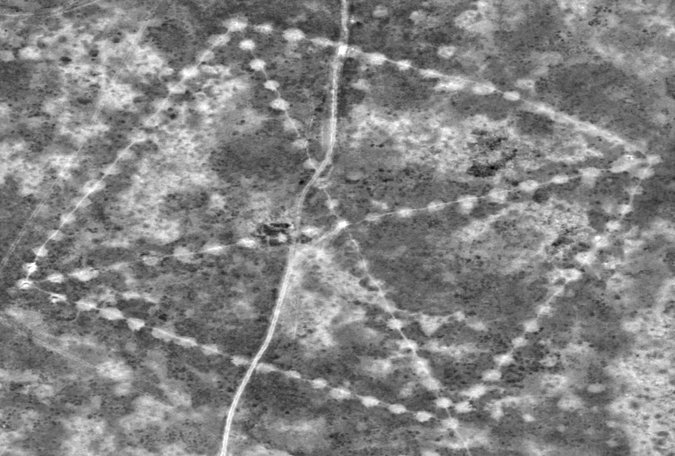
You know how left-brained individuals always have reasons for the unexplainable? Like how crop circles are all hoaxes. Well, you logical souls, explain this. According to a recently published New York Times article, two weeks ago NASA released satellite photographs of earthworks found in Kazakhstan. These earthworks are recognizable from the air only, are huge, and the oldest is estimated to be 8,000 years old.
Seems scientists and archeologists are having a little difficulty explaining these virtually unstudied ancient mysteries.
ProbeFiling

(ProbeNote: Earthworks is terminology used by archeologists and refers to artificial changes in land level typically made from piles of artificially placed or sculpted rocks and soil.)
(ProbeNote: Kazakhstan is the ninth largest country in the world, the second largest republic in the former Soviet Union, is sandwiched at the crossroads of Asia and Europe, and is oil rich.)
NASA’s space age technology made it possible to photograph these earthworks referred to as the Steppe Geoglyphs or Turgai Geoglyphs. These findings are largely unknown to the outside world. Kazakhstan has been slow to research and protect these ancient geoglyphs resulting in little new information on the findings.

There are as many as 260 of these earthworks made up of mounds, trenches and ramparts arranged in five basic patterns. The largest (top photo) is near a Neolithic (New Stone Age) settlement and is comprised of a 101 raised mounds in the formation of a large square with its opposite corners connected by a diagonal cross. It covers more terrain than the Great Pyramid of Cheops.
The earthworks were first spotted by Dmitriy Dey, a Kazakh economist and archaeology enthusiast, on Google Earth in 2007. His curiosity as to why there were are pyramids in Kazakhstan lead him to the discovery. Dey is now head of the research project for the the Turgai Discovery and offers an informative power point presentation. Check it out if you want a more detailed description of his findings.
It’s been reported that Senior Washington biospheric scientist for NASA, Compton J. Tucker, said, “I’ve never seen anything like this. I found it remarkable,” to Dey and The New York Times.
The REAL News: This past week, NASA put the Turgai Geoglyphs on a task list for astronauts in the International Space Station to photograph.

Dey dismisses theories we alien hunters hold dear such as the earthworks being proof of ancient alien influence. He doesn’t believe they were meant to be seen from the air. (Really?) Instead, he reasons that the figures built along straight lines on elevations were “horizontal observatories to track the movements of the rising sun.”
Okay sure. But it seems to me there had to be someone or something in the sky telling all those Neolithic beings where to place the next rock to create the sun dial.
Some 100,000 million years ago during the Cretaceous Period, the fertile lands of the steppe were a destination for Stone Age tribes seeking hunting grounds. Dey suggests that the Mahandzhar culture, which thrived from 7,000 B.C. to 5,000 B.C., could be linked to the geoglyphs.
However, scientists seem a bit baffled that a nomadic population would have stayed in place for the time required to undertake such a large-scale project—lay timber for ramparts and dig out lake bed sediments to construct the enormous mounds. It is reported that originally these mounds were 6 to 10 feet high—now 3 feet high—and nearly 40 feet across.
Seems an unlikely scenario for wayfaring tribes, don’t you think?

Some scientists—like Giedre Motuzaite Matuzeviciute, an archaeologist from Cambridge University—are uncertain as to whether the discoveries should be categorized as geoglyphs since these refer to art not objects with function. The Nazca Lines of Peru are examples of such geoglyphs in that they depict animals and plants.
But who is around to say that the Nazca Lines didn’t serve as objects of function as well as art back in the days when space gypsies roamed the Earth skies?
The Probe’s Mission Statement

The Probe is a blog devoted to the exploration of the unexplainable, to finding the truth in occurrences that resemble science fiction, and to researching and reporting on topics that could be flung upon the wall of weird. New posts are featured every week.
I’m releasing my blog early this week because it’s one of those topics that I’m excited to tell you about. NASA just got involved this past week in the Turgai Geoglyphs so it’s relatively new news. I’d love to hear what you think. Nomads or Ancient Aliens? You know my vote.
Sign up to get my weekly, slightly irregular blog posts delivered directly to your email. No spam. Promise.

- Urban Legend in the Making - April 22, 2024
- Coghlan’s Traveling Coffin Urban Legend - April 4, 2024
- Richmond Vampire Urban Legend - March 7, 2024
